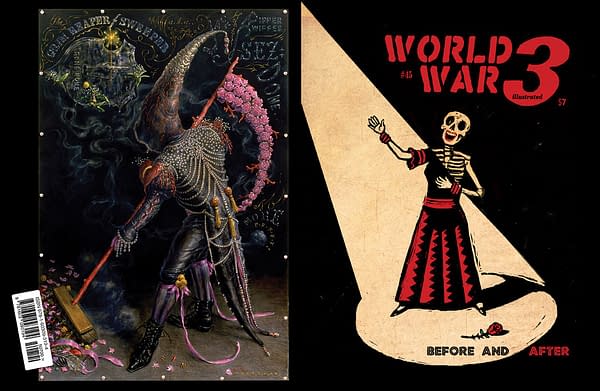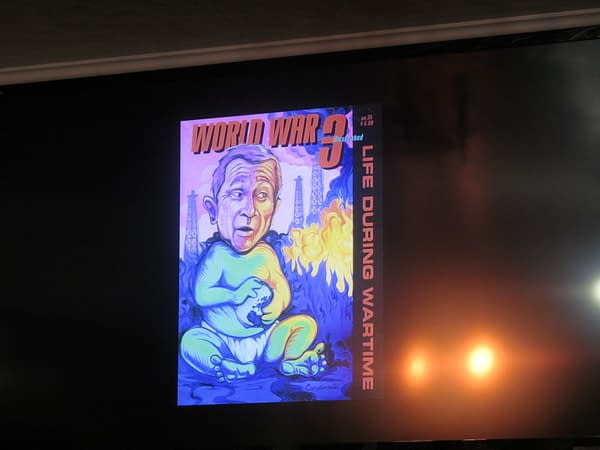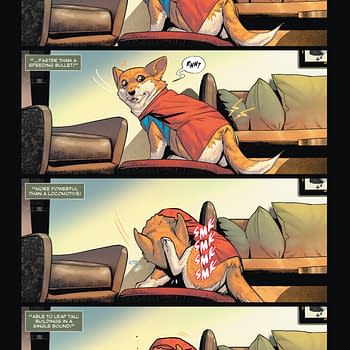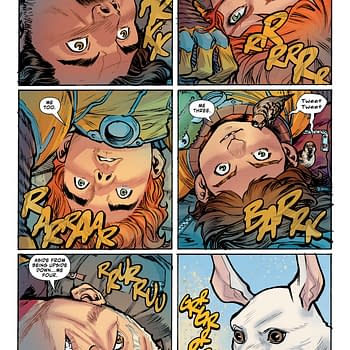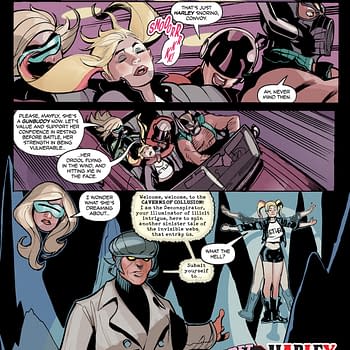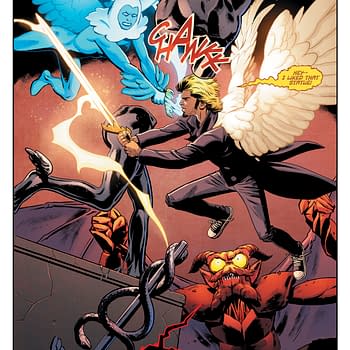Posted in: Comics, Recent Updates | Tagged: Comics, entertainment, Kevin Pyle, Peter Kuper, Sabrina Jones, Sandy Jimenez, Seth Tobocman, underground comix, World War 3 Illustrated
World War 3 Illustrated, An 'Open Platform For Protest' Celebrates 35 Years At MoCCA Fest
I've been told that a project based on volunteers, and particularly a project that creates comics, rarely has longevity. Attending the "History of World War 3 Illustrated" panel at MoCCA Fest in New York this past weekend taught me otherwise, and to some extent, my mind is still processing that a work of such integrity has been produced over a period of more than 30 years with such continuous momentum and relevance.
Moderator Calvin Reid of Publishers Weekly introduced a small battalion of WW3 editors and contributors, and we later learned that a number of contributors were waiting quietly in the audience also, listening to what their colleagues had to say. One of the landmarks that dignified the panel event was the recent release of the Kickstarter-funded large hard back anthology collecting selected comics in a topic-based and chronological system of arrangement, essentially telling the history and the concerns of WW3 Illustrated over the years.
Reid described WW3 Illustrated as an "open platform for protest", a venue for "setting the story straight" regarding political and social issues, featuring "small, powerfully local interests regularly fucked over and ignored by government interest". He also noted the propensity of WW3 to document the "slow transformations of neighborhoods from real communities to wastelands".
Panelists included Sandy Jimenez, Seth Tobocman, Peter Kuper, Sabrina Jones, and Kevin Pyle, many of whom had worked as both editors and contributors in the anthology's 30 year history.
For Peter Kuper and Seth Tobocman, the history of WW3 goes back, way back to meeting in the 1st grade. At age 7, the two started reading comics and fell in deep, producing their first fanzine at age 11, attending comic cons in 1970, and even meeting Harvey Pekar when he working as a hospital worker in their native Cleveland.
Kuper discussed the history of cartoons and comics that deliver social critiques, and felt that comics possess this impulse in their very "DNA" since storytelling leads to talking about what's "going on in the world at that time". He mentioned the magazines which were "shut down" during WWI in Germany, and the fact that many artists were "threatened with death for doing the kind of images they were doing" to critique society at the time. In the USA, during the Depression era, of course, the WPA, gave artists jobs doing art rather than expecting them to seek other types of employment, and on the heels of that serious treatment of comics, war comics in 50's gave increasing momentum to socially relevant and hard-hitting themes in horror, sci-fi, and war comics genres. The brick wall comics hit in the form of Frederic Wertham "sent comics back into its infancy", Kuper said.
Tobocman picked up the narrative thread with Zap! and other underground comix, which, contrary to false generalizations, contained "a lot of politics" rather than just sex and drugs. Things were "not just smiling" in 70's, he clarified. The title "WW3" came from a book by British military leader in 1979 called WWIII, about how a third World War could be waged and how to "win it", which closely reflected the thinking of the Pentagon and NATO at the time, though the average Joe found the book to be quite shocking in its attitudes. In particular the thing that prompted Tobocman to found the magazine with Kuper was the realization during the Iran hostage crisis that people were suddenly coming forward with strong opinions against Iran despite ignorance of the country and a tendency toward more staid attitudes. "I have a right to opinion if they do", he realized, and set to work using his skills from creating fanzines to start a magazine of "political opinion".
Reid brought up the subject of the "volunteer" status of editors and contributors and asked how the financial dynamic of the magazine worked. Tobocman explained that the policy on the magazine is that if people do work, they keep the rights to the work, meanwhile receiving distribution of 2-6 thousand copies. There is, however, an increase in influence over the magazine if people "do work beyond their own material", such as becoming members of the editorial board to determine what goes into magazine and what doesn't. The motivation to participate in the magazine is simple, Tobocman said. "People need a place" to express their views, even though the magazine itself has no "specific political line". It's open to different points of view as long as "you express it with some integrity", he explained.
Kuper filled the audience in on the social context of WW3's launch in the 70's. There had been a distinct decline in the appreciation of the comics medium, with "head shops" that usually stocked Underground comix being shut down and the scaling back of venues where comics might be taught as an art form. There were plenty of people who "deeply believed in" comics being told they weren't valuable and therefore they weren't finding any venues for publishing their work. So, for Kuper and Tobocman, and for WW3, it was "either do it that way" as a volunteer magazine, or find no other venue for publication. Either way, they weren't going to get paid, so they might as well do it and accomplish something, they felt.
Kevin Pyle confirmed that the idea of getting paid wasn't something he thought about. Participating in WW3 was "more about having venues for expressing self". Sabrina Jones agreed, "You do your art, then figure out how to get paid" rather than the other way around.
Kuper put a finer point on it by suggesting that the reason the magazine has been around for 35 years is specifically because they didn't make money, therefore they weren't constantly arguing about money. The ethos of WW3 has always been to start with "doing the thing" and creating the art out of personal desire to do so.
Sandy Jimenez discovered WW3 when he was just out of college and "discovered some issues at Forbidden Planet". He was attracted to the subject matter of protest movements and class war. Going along to a meeting, he found that contributors "looked like a bunch of kids" rather than "withered old hippies" and he was sold.
The fact that the magazine was not driven by profit also appealed to him. He thought of the volunteer aspect as a way of "buying their own freedom to do their comics the way they wanted to" and therefore being free of outside control, interests, or responsibilities.
Some aspects of WW3 that appealed to many of the panelists were its ability to provide a distinctive aesthetic as well as politics, the in-person discussions and meetings, and the development of a network that could reach all over the country and around the world to places "where people don't know there's anyone else who thinks like they do".
Reid asked how the editors decide on acceptance and rejection of submissions to the magazine, commenting humorously that he once submitted a cartoon himself and that is was rejected. Kuper said that occasionally people want to contribute but the comic is not clearly understandable in the way it needs to be, or it takes "cheap shots at people", which is never their agenda, such as one comic they received that made fun of a councilman for being gay rather than for his economic policies.
Kuper acknowledged that their decision-making isn't perfect, but since asking people to make "changes" on comics they are doing for free is difficult, they haven't always been exacting when it comes to art style, instead focusing on "reading for content". The art might not be "spot on", but the artist might need encouragement to go forward and improve. Tobocman added that "if people have a place where they can interact with people their work gets better" and he's often seen great improvements among contributors over time.
Since the magazine has spanned many years, one question during Q &A broached the subject of how WW3 has met technological change. Using Facebook to arrange meetings or discussions hasn't necessarily worked as well as they might have hoped since the kinds of discussions editors and contributors need to have on the magazine tend to work better face to face. For that reason, they've continued to prefer meet ups. Skype is a slightly better alternative, giving more human interaction. Kuper reflected on the changes in printing methods that have altered the way they produce the magazine, from its early days of print when they could oversee the actual printing-press production and make sure the details and ink were right to the current use of thumb-drives and sending the magazines away for publication, which can result in quality-control issues.
For the hardcover collection, however, they've used a trusted publisher who Kuper has worked with multiple times before. Talking to other publishers beforehand, they found skepticism and demands that they publish the collection "small, and black and white" as companies nervously attempted to assure themselves that they wouldn't lose money producing the book.
PM Press "stepped up" to publish a full color book with a hard cover, and "no page ceiling". The book "shows off" the work of WW3 "properly" versus being apologetic about it, Kuper said. For him, the book marks a step to "codify something", since WW3 has worn a "cloak of invisibility for many years now" in terms of permanency. Now, with a hard cover, it's more likely to be seen in libraries and schools, contributing to posterity. The new collection covers the years from 1979-2014 and contains explanatory chronologies of social events and concerns to coincide with the selection of comics.
The most recent magazine, however, is also currently available:
